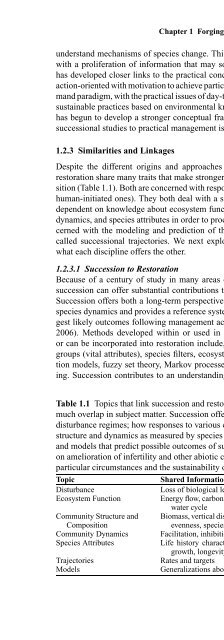Linking Restoration and Ecological Succession (Springer ... - Inecol
Linking Restoration and Ecological Succession (Springer ... - Inecol
Linking Restoration and Ecological Succession (Springer ... - Inecol
You also want an ePaper? Increase the reach of your titles
YUMPU automatically turns print PDFs into web optimized ePapers that Google loves.
Chapter 1 Forging a New Alliance Between <strong>Succession</strong> <strong>and</strong> <strong>Restoration</strong> 7<br />
underst<strong>and</strong> mechanisms of species change. This is a classic supply paradigm,<br />
with a proliferation of information that may someday be useful. <strong>Restoration</strong><br />
has developed closer links to the practical concerns of managers <strong>and</strong> is more<br />
action-oriented with motivation to achieve particular results. This is a classic dem<strong>and</strong><br />
paradigm, with the practical issues of day-to-day management dem<strong>and</strong>ing<br />
sustainable practices based on environmental knowledge. <strong>Restoration</strong> ecology<br />
has begun to develop a stronger conceptual framework but the application of<br />
successional studies to practical management issues is still inadequate.<br />
1.2.3 Similarities <strong>and</strong> Linkages<br />
Despite the different origins <strong>and</strong> approaches noted above, succession <strong>and</strong><br />
restoration share many traits that make stronger linkages an achievable proposition<br />
(Table 1.1). Both are concerned with responses to disturbance (especially<br />
human-initiated ones). They both deal with a subset of the l<strong>and</strong>scape <strong>and</strong> are<br />
dependent on knowledge about ecosystem function, community structure <strong>and</strong><br />
dynamics, <strong>and</strong> species attributes in order to proceed. In addition, both are concerned<br />
with the modeling <strong>and</strong> prediction of the sequence of discrete events<br />
called successional trajectories. We next explore these linkages in terms of<br />
what each discipline offers the other.<br />
1.2.3.1 <strong>Succession</strong> to <strong>Restoration</strong><br />
Because of a century of study in many areas of the globe, the discipline of<br />
succession can offer substantial contributions to the discipline of restoration.<br />
<strong>Succession</strong> offers both a long-term perspective <strong>and</strong> short-term predictions on<br />
species dynamics <strong>and</strong> provides a reference system for restoration that can suggest<br />
likely outcomes following management actions (Aronson <strong>and</strong> van Andel<br />
2006). Methods developed within or used in studies of succession that are<br />
or can be incorporated into restoration include, for example, functional plant<br />
groups (vital attributes), species filters, ecosystem assembly, state <strong>and</strong> transition<br />
models, fuzzy set theory, Markov processes, <strong>and</strong> biogeochemical modeling.<br />
<strong>Succession</strong> contributes to an underst<strong>and</strong>ing that multiple trajectories are<br />
Table 1.1 Topics that link succession <strong>and</strong> restoration. Studies of succession <strong>and</strong> restoration share<br />
much overlap in subject matter. <strong>Succession</strong> offers restoration insights into: responses to different<br />
disturbance regimes; how responses to various ecosystem functions reflect changes in community<br />
structure <strong>and</strong> dynamics as measured by species attributes; generalizations about possible trajectories;<br />
<strong>and</strong> models that predict possible outcomes of succession. <strong>Restoration</strong> offers succession practical data<br />
on amelioration of infertility <strong>and</strong> other abiotic constraints as well as input about species interactions in<br />
particular circumstances <strong>and</strong> the sustainability of various successional communities.<br />
Topic Shared Information<br />
Disturbance Loss of biological legacy (severity), disturbance regime<br />
Ecosystem Function Energy flow, carbon accumulation <strong>and</strong> storage, nutrient dynamics, soil properties,<br />
water cycle<br />
Community Structure <strong>and</strong> Biomass, vertical distribution of leaf area, leaf area index, species richness, species<br />
Composition<br />
evenness, species density, spatial aggregation<br />
Community Dynamics Facilitation, inhibition, dispersal (priority effects <strong>and</strong> entrapment), sustainability<br />
Species Attributes Life history characteristics (pollination syndrome, germination, establishment,<br />
growth, longevity)<br />
Trajectories Rates <strong>and</strong> targets<br />
Models Generalizations about processes

















